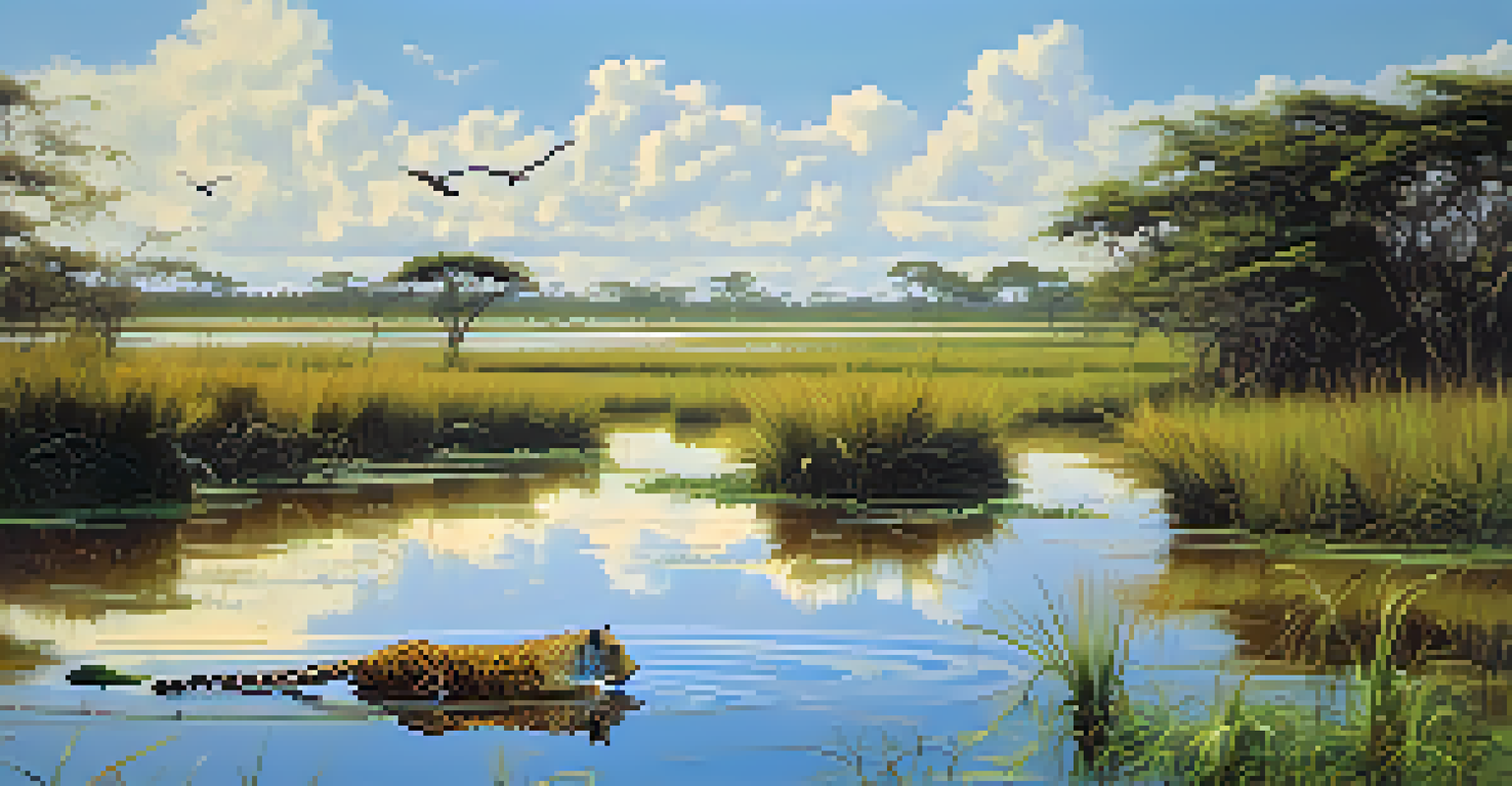Exploring the Biodiversity of Brazil's Rare Wildlife Sanctuaries

Introduction to Brazil's Biodiversity Hotspots
Brazil is home to an astonishing array of biodiversity, often hailed as one of the most biologically rich countries on the planet. With its vast rainforests, wetlands, and savannas, it offers a sanctuary for countless species, some of which are found nowhere else on Earth. These unique ecosystems are essential not only for wildlife but also for the health of our planet, contributing to climate regulation and natural resources.
The greatest threat to our planet is the belief that someone else will save it.
The significance of Brazil's biodiversity goes beyond its beauty; it is crucial for ecological balance and human survival. The country hosts roughly 10% of all known species, including iconic animals like the jaguar, Amazon river dolphin, and countless bird species. Protecting these habitats is imperative, as they are under constant threat from deforestation, climate change, and urbanization.
In this article, we will explore some of Brazil's rare wildlife sanctuaries, focusing on their unique ecosystems and the incredible creatures that inhabit them. Each sanctuary plays a vital role in conservation efforts, making them essential destinations for wildlife enthusiasts and conservation advocates alike.
The Amazon Rainforest: A Lush Sanctuary
The Amazon Rainforest is perhaps the most famous of Brazil's wildlife sanctuaries, often referred to as the 'lungs of the Earth.' Stretching across multiple countries, this vast expanse is home to an unparalleled diversity of flora and fauna. From towering trees to vibrant orchids, the rainforest's ecosystem supports species such as sloths, toucans, and poison dart frogs, each playing a unique role in the environment.

However, the Amazon faces severe threats from logging, agriculture, and mining. Conservation initiatives are crucial for protecting this invaluable habitat and the species that rely on it. Organizations and local communities are working tirelessly to promote sustainable practices, ensuring that future generations can experience the wonders of the rainforest.
Brazil's Biodiversity is Unique
Brazil hosts approximately 10% of all known species, making it a vital area for ecological balance and conservation.
Visiting the Amazon allows travelers to immerse themselves in nature while supporting conservation efforts. Guided tours offer opportunities to spot rare wildlife and learn about the delicate balance of the ecosystem, fostering a deeper appreciation for this natural wonder.
Pantanal: The World's Largest Tropical Wetland
The Pantanal is another gem of Brazil's biodiversity, recognized as the world's largest tropical wetland. Spanning over 75,000 square kilometers, it is a haven for wildlife, especially during the seasonal floods that create a rich habitat for various species. Here, visitors can encounter jaguars, capybaras, and hundreds of bird species, making it a top destination for wildlife photography and birdwatching.
In every walk with nature, one receives far more than he seeks.
This unique ecosystem is crucial for maintaining water quality and supporting numerous fish species, which are integral to the local economy. However, the Pantanal is also threatened by agriculture, cattle ranching, and climate change, leading to habitat loss and biodiversity decline. Conservation efforts focus on sustainable land use and protecting the delicate balance of this wetland.
Exploring the Pantanal offers an unforgettable experience, with opportunities for eco-friendly tours and wildlife spotting. Travelers can witness the incredible biodiversity while learning about the importance of preserving this enchanting landscape.
Atlantic Forest: A Biome in Peril
The Atlantic Forest, or Mata Atlântica, is a breathtaking yet endangered ecosystem that once covered a vast area along Brazil's coast. Today, only a fragment of this lush forest remains, making it one of the most threatened ecosystems in the world. Home to unique species such as the golden lion tamarin and the Brazilian tapir, the Atlantic Forest is a vital area for biodiversity conservation.
Urbanization, agriculture, and logging have drastically reduced the forest's size, pushing many species to the brink of extinction. Conservation projects aim to restore and protect these critical habitats, emphasizing the need for sustainable practices and environmental awareness. Reforestation efforts are also underway to help recover lost biodiversity and habitat.
Threats to Wildlife Sanctuaries
Deforestation, climate change, and urbanization pose significant threats to Brazil's diverse ecosystems and their inhabitants.
Exploring the Atlantic Forest reveals the beauty and fragility of this ecosystem. Nature trails and guided tours provide opportunities to see endemic species while supporting the local communities dedicated to preserving this vital biome.
Serra da Canastra: A Unique Mountain Sanctuary
Serra da Canastra National Park is a stunning mountain sanctuary that showcases Brazil's diverse ecosystems. Located in the southeastern part of the country, this park is known for its dramatic landscapes, including waterfalls, plateaus, and rich wildlife. The park is home to unique species such as the maned wolf and the Brazilian endemic bird species, making it a treasure trove for nature lovers.
The park plays a critical role in water conservation, as it is the source of several important rivers. Protecting this area not only preserves its biodiversity but also ensures the availability of water resources for surrounding communities. Efforts to promote sustainable tourism help raise awareness about the importance of conservation in this breathtaking region.
Visitors to Serra da Canastra can hike through its scenic trails, enjoy birdwatching, and marvel at the stunning waterfalls. Engaging with local conservation initiatives enhances the experience, fostering a sense of responsibility towards preserving this unique ecosystem.
Biodiversity Conservation Efforts in Brazil
Conservation efforts in Brazil are crucial for protecting its rich biodiversity. Various organizations, both governmental and non-governmental, are working tirelessly to preserve endangered species and restore damaged ecosystems. Through community engagement, education, and research, these initiatives aim to create a sustainable future for Brazil's wildlife.
Protected areas, such as national parks and reserves, serve as safe havens for many species. However, these efforts must be complemented by sustainable land-use practices and policies that address the root causes of habitat destruction. Collaboration between local communities, governments, and international organizations is essential to achieve long-term conservation goals.
Eco-Tourism Supports Conservation
Engaging in eco-tourism helps raise awareness and funds for conservation efforts, benefiting both local economies and wildlife protection.
By raising awareness and promoting responsible tourism, individuals can contribute to conservation efforts. Every visit to Brazil's wildlife sanctuaries helps support local economies while fostering a deeper understanding of the importance of biodiversity.
The Role of Eco-Tourism in Wildlife Protection
Eco-tourism has emerged as a powerful tool for wildlife protection in Brazil. By promoting responsible travel practices, eco-tourism helps raise awareness about the importance of conserving natural habitats and the species that inhabit them. Travelers who engage in eco-friendly tours contribute to local economies while supporting conservation projects.
Many wildlife sanctuaries offer guided eco-tours that educate visitors about the unique ecosystems and their inhabitants. These experiences foster a sense of connection between travelers and nature, highlighting the need to protect these precious environments. Additionally, some tour operators actively participate in conservation initiatives, ensuring that profits support local wildlife protection efforts.

Choosing eco-tourism not only enriches your travel experience but also plays a vital role in preserving biodiversity. By supporting responsible tourism, you can help ensure that Brazil's rare wildlife sanctuaries continue to thrive for generations to come.
Conclusion: The Future of Brazil's Biodiversity
The future of Brazil's biodiversity hinges on our collective actions today. As we explore the country's rare wildlife sanctuaries, we must recognize the importance of conservation and sustainable practices. Every effort counts, whether it's supporting local initiatives, responsible tourism, or raising awareness about the value of biodiversity.
Brazil's unique ecosystems not only hold incredible wildlife but also play a key role in global health and sustainability. Protecting these habitats is essential for maintaining ecological balance and supporting human life. By working together, we can ensure that future generations experience the beauty and wonder of Brazil's natural heritage.
Brazil's Biodiversity is Unique
Brazil's diverse ecosystems, including the Amazon Rainforest and Pantanal, are home to countless species and play a crucial role in maintaining ecological balance.
In conclusion, exploring Brazil's wildlife sanctuaries offers a chance to connect with nature and understand the importance of preservation. Let’s embrace the responsibility to protect these treasures, ensuring their survival for years to come.